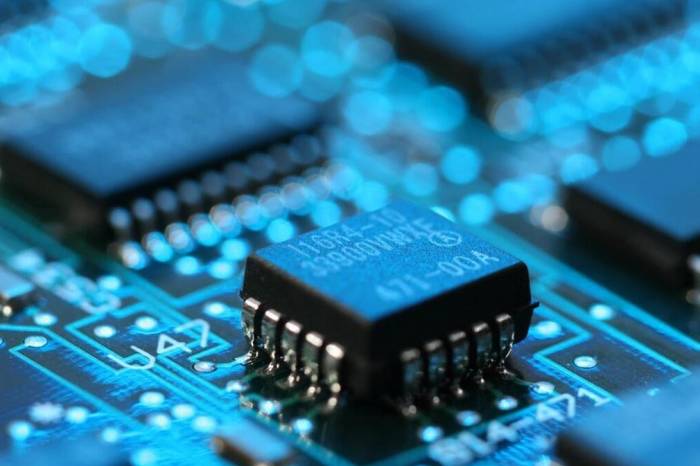Semiconductor Boom: Index Soars
The current landscape of China's stock market, particularly the A-shares, is showing intriguing signs of a mild bull trend. The Shanghai and Shenzhen stock indices began the day with a low opening but quickly rebounded, forming substantial bullish candlesticks. This movement is indicative of an uplifting momentum, as both indices are now only a few points away from their respective highs set on October 8th. Investors and analysts suggest that breaking through these previous peaks is just around the corner.
Leading this upward trajectory are the tech-focused boards, namely the ChiNext and the Sci-Tech Innovation Board, which have seen impressive gains of 3% and 4.7%, respectively. The STAR 50 Index is on the verge of surpassing its prior month’s high, with a likelihood of achieving a new peak before the end of trading tomorrow. This enthusiasm reflects broader market confidence, particularly among technology stocks.
Among various sectors, semiconductors have emerged as the standout performer of the day, soaring by an impressive 7.15%. This rally has attracted significant capital inflow, estimated at around 3.7 billion RMB. Notable stocks such as Shanghai HJT and Chipset have seen trading surges, indicating a robust demand for semiconductor shares. Such performance underscores the critical role this sector plays in the overall market landscape.
However, the semiconductor field has been on an upward trajectory for much longer than just today. Since the start of the 924 rally, this sector has consistently ranked among the top gainers, paralleling the performance of the securities sector as both rise together. In fact, as early as February 2021, the semiconductor index reached a low, but over the past nine months, it has witnessed a remarkable 120% increase, making it the highest gaining sector in the market.
Moreover, the semiconductor industry has the notable distinction of being the first sector to surpass its 2021 highs. Back in November 2021, this industry reached a historic peak of 9,770 points before plummeting to 4,216 points in February – a decline of nearly 60%. Yet, as of now, the index has climbed back to 9,294 points, just 476 points shy of its record high. This suggests that a mere 5% increase could easily bridge the gap back to the peak, raising expectations that this milestone may be achieved within the week.
The explosive growth of semiconductors can be attributed to a solid industrial foundation and vast potential for innovation. This industry is crucial for overcoming technological bottlenecks and is seen as essential for the country's strategic advancements. The establishment of the Sci-Tech Innovation Board in 2019 was driven by this determination to bolster the semiconductor sector, which now houses many of China’s leading semiconductor enterprises. The outcomes of these initiatives will be pivotal for China's broader industrial progress and competitiveness.

From an industry perspective, China stands as the world’s largest consumer electronics market, largest industrial producer, largest home appliance manufacturer, and largest automotive market in terms of both production and consumption. Furthermore, it is one of the leading internet nations globally. In the era of smart technologies on the rise, chips are at the core of all industries. They are the essential components steering the direction of progress across the sector.
Previously, the landscape was characterized by free globalization, wherein international division of labor allowed for easy buying and selling across borders. This status quo began to change in 2018, as trade wars led by the United States shifted the dynamics, limiting access to critical components. As a result, the need for domestically produced, self-sufficient alternatives has become imperative. With the return of a more unpredictable and aggressive stance from the U.S., the pressure on China to achieve self-sufficiency in semiconductor technology has intensified, making the domestic replacement imperative even more urgent.
Currently, China imports over 2 trillion RMB worth of semiconductors annually, making it the country’s largest imported commodity. This represents a massive market that, previously, many companies hesitated to tackle due to the complexities involved. With no viable alternatives left, the large domestic market becomes alluring, and significant capital investment has poured into the sector over the past six years. Currently, China has cultivated the most comprehensive semiconductor supply chain in the world, reflecting a compelling potential demand that presents attractive opportunities for industry players.
Evaluating the current valuation of the semiconductor sector reveals an average P/E ratio of 73 times. Is this valuation excessive? Determining whether it is indeed excessive requires context; while it might seem relatively high, comparisons with other tech companies show this is within a reasonable range. Companies like NVIDIA carry P/E ratios of 68 times, while Broadcom reaches 168 times. Historically speaking, during 2015’s market frenzy, the ChiNext had average valuations soaring to 200 times, and the Sci-Tech board had its peak at around 90 times in 2021.
In context, with the importance of semiconductors surging and the sector being poised for substantial growth, a P/E ratio in the 70s seems less extravagant. Money flowing into this sector in the secondary market highlights the process of resource reallocation, responding to the elevated significance of the semiconductor industry in the current economic climate.
Nevertheless, globally, the semiconductor industry's technological advancements have been slow. For countries like China, which are trying to catch up, this scenario is advantageous. The mounting external pressures and fierce competition magnify the reliance on and expectations for domestic replacements in the semiconductor industry. Through concerted efforts, the hope remains that this industry will eventually achieve significant breakthroughs, potentially transforming into a cornerstone of modern production capabilities for the nation.
Leave A Comment